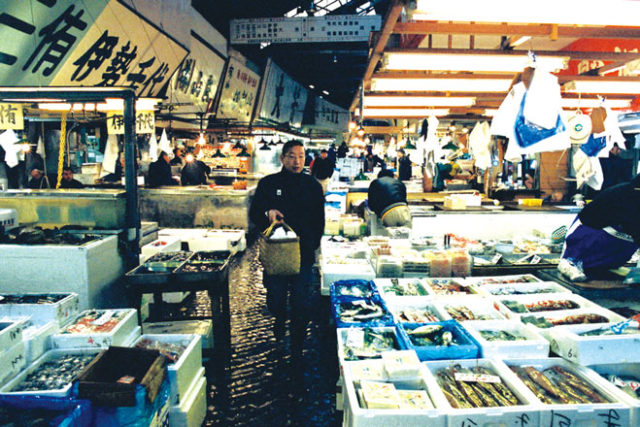By Yukiko Tanaka
For The North American Post
The word, tsukiji, means, “reclaimed land.” In rebuilding the area, not far from the castle, after it burned down from big fire of 1650, the shogun’s government decided to create a large open space in order to stop fire from spreading. A few canals were added and some more land was reclaimed then, thus the name of Tsukiji.
Many of us think of fish or sushi in association with the name of Tsukiji and indeed, there is a large market there, of which its proper name is the Tokyo Central Wholesale Market. There is a produce section as well and both are under the supervision of the Tokyo metropolitan government. Tsukiji Fish Market has been popular among foreign visitors for some time, but recently that number has become so great (despite its early start at 5 am) that it has interfered with normal operation of the market and visitors now have to apply beforehand. Visitors’ interest lies in the auction that takes place in the market, perhaps, because the way they carry it out is a uniquely Japanese way, but I do not know. What is clear to me is that no matter what part of the world in which they are, markets are always interesting to look at and to be a part of. I myself make a point of going when I visit foreign countries.
The highlight of the auction at Tsukiji Market is that of tuna. The best tuna, it is said, is from off the coast of Oma in the northernmost of Japan, Aomori Prefecture. At the first auction of the year 2016, it fetched 140,000 yen a fish according to television news. If you slice it to put on a nigiri, in other words, that piece cost 1,000 yen. It is hard to comprehend such a matter, but terms such as “excessive” have crossed my mind.
Outside the market itself but on its compound are many stores and stalls, selling fish and other food. There are small restaurants as well, open all day long (the market closes by noon, or a bit earlier). Prices here are supposed to be lower than elsewhere and it is generally very crowded, but a map listing all the stores and restaurants is available.
The Fish Market, which had once been in Nihonbashi before it moved to Tsukiji, will be relocated again at the end of 2016, further east to Toyosu, another reclaimed land along Tokyo Bay. The move is necessary, says the Tokyo Municipal government, since the buildings are old and unsafe and the site is overly congested. Some suspect, however, the move is because of the value of the land it sits on, which is very desirable being so close to Ginza. How it will be used after the move has not been talked about at all. The new location definitely has a poor access. Although the mayor has suggested a water bus, it remains to be seen if the new market will be as popular as the Tsukiji Market.
The spot where Tsukiji Market stands now had not seen the firebombing, thus the buildings are old indeed and mostly wooden. And a temple called Ensho-ji, which stands being squished by all the market stalls surrounding it, looks very old. This temple, along with some wooden houses further away in and around 7-chome are registered by UNESCO’s “world heritage in critical condition,” meaning that the structure faces the danger of being lost unless something is done now. Exactly what this means to the temple and those houses I do not know, but for now they stand there revealing the beauty and calm that comes from very old wooden structures.
Tsukiji is not only about the fish market. It has another landmark, Honganji Temple. A large dorm-like structure, which does not quite fit the ambience of Ginza, sits on the other side of Harumi-dori, a bit closer to Ginza. It is the main temple of the Jodo-shinshu school of Buddhism (Rissho-ji is also of the same school). That those temples are here today, and for such a long time, can be understood by their histories. The fishermen, who were relocated by Tokugawa Ieyasu to a nearby tiny island of Tsukuda-jima, were all devoted believers of Jod-shinshu, and they built their temple here in Tsukiji, the first one in early the 17th century.
After having been burned down so many times, the present Hongan-ji Temple is built of concrete and stone and its outer appearance reminds us of Indian temples, since it was designed by an architect who traveled to India to gain inspiration (besides, Buddhism was born in India). It is quite large, accommodating congregations of up to one thousand.
[Editor’s Note]
This series will be published every week. The writer can be reached atytanaka03@gmail.com.







